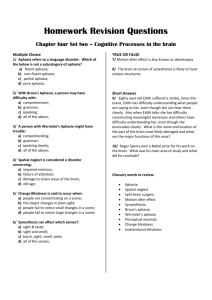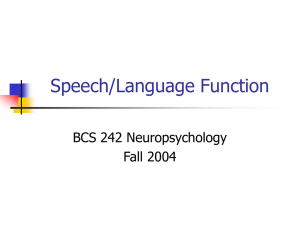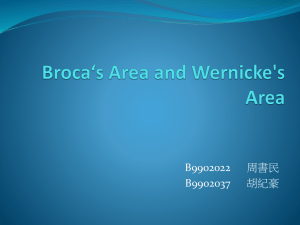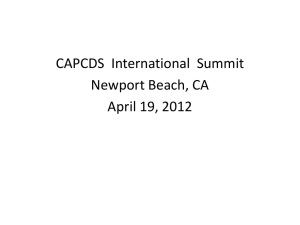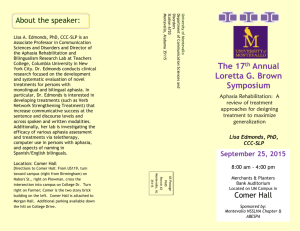Aphasia Types: Fluent vs. Nonfluent, Characteristics & Lesions
advertisement
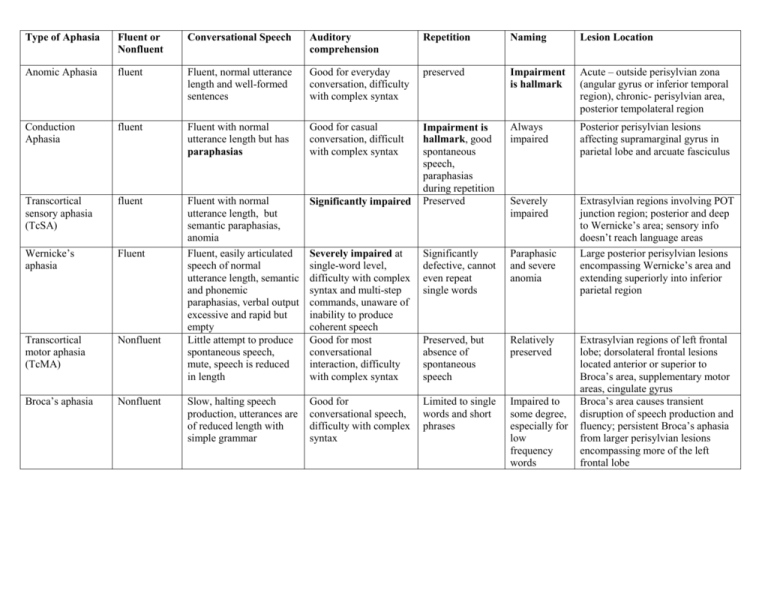
Type of Aphasia Fluent or Nonfluent Conversational Speech Auditory comprehension Repetition Naming Lesion Location Anomic Aphasia fluent Fluent, normal utterance length and well-formed sentences Good for everyday conversation, difficulty with complex syntax preserved Impairment is hallmark Acute – outside perisylvian zona (angular gyrus or inferior temporal region), chronic- perisylvian area, posterior tempolateral region Conduction Aphasia fluent Fluent with normal utterance length but has paraphasias Good for casual conversation, difficult with complex syntax Always impaired Posterior perisylvian lesions affecting supramarginal gyrus in parietal lobe and arcuate fasciculus Transcortical sensory aphasia (TcSA) fluent Significantly impaired Severely impaired Wernicke’s aphasia Fluent Significantly defective, cannot even repeat single words Paraphasic and severe anomia Nonfluent Severely impaired at single-word level, difficulty with complex syntax and multi-step commands, unaware of inability to produce coherent speech Good for most conversational interaction, difficulty with complex syntax Extrasylvian regions involving POT junction region; posterior and deep to Wernicke’s area; sensory info doesn’t reach language areas Large posterior perisylvian lesions encompassing Wernicke’s area and extending superiorly into inferior parietal region Transcortical motor aphasia (TcMA) Fluent with normal utterance length, but semantic paraphasias, anomia Fluent, easily articulated speech of normal utterance length, semantic and phonemic paraphasias, verbal output excessive and rapid but empty Little attempt to produce spontaneous speech, mute, speech is reduced in length Impairment is hallmark, good spontaneous speech, paraphasias during repetition Preserved Preserved, but absence of spontaneous speech Relatively preserved Broca’s aphasia Nonfluent Slow, halting speech production, utterances are of reduced length with simple grammar Good for conversational speech, difficulty with complex syntax Limited to single words and short phrases Impaired to some degree, especially for low frequency words Extrasylvian regions of left frontal lobe; dorsolateral frontal lesions located anterior or superior to Broca’s area, supplementary motor areas, cingulate gyrus Broca’s area causes transient disruption of speech production and fluency; persistent Broca’s aphasia from larger perisylvian lesions encompassing more of the left frontal lobe Type of Aphasia Fluent or Nonfluent Conversational Speech Auditory comprehension Repetition Naming Lesion Location Mixed transcortical aphasia (MTcA), isolation syndrome perisylvian zone disconnected from extrasylvian regions Global aphasia nonfluent Meaningful verbal expression is severely limited or absent, inappropriate repetition of what other say Markedly impaired at single-word level Preserved, although repetition occurs without comprehension Significantly impaired Diffuse/mulitfocal lesions resulting in anatomic isolation of perisylvian language from surrounding cortical areas (periphery of middle cerebral artery distribution) Nonfluent Slow, halting speech production, single words Reduced to the extent that single-word comprehension is impaired Defective and single words may not be repeated accurately Severely impaired Extensive and involve the entire left perisylvian language zone; common cause is embolic occlusion of the main stem of the middle cerebral artery Other Aphasias - subcortical regions include thalamic aphasia, basal ganglia aphasia, surrounding white matter aphasia - associated with dementia; Alzheimer’s disease language deterioration follows progressive course beginning with anomic aphasia transcortical sensory aphasia Wernicke’s aphasia global aphasia - primary progressive aphasia (PPA) progressive language deterioration without significant dementia
